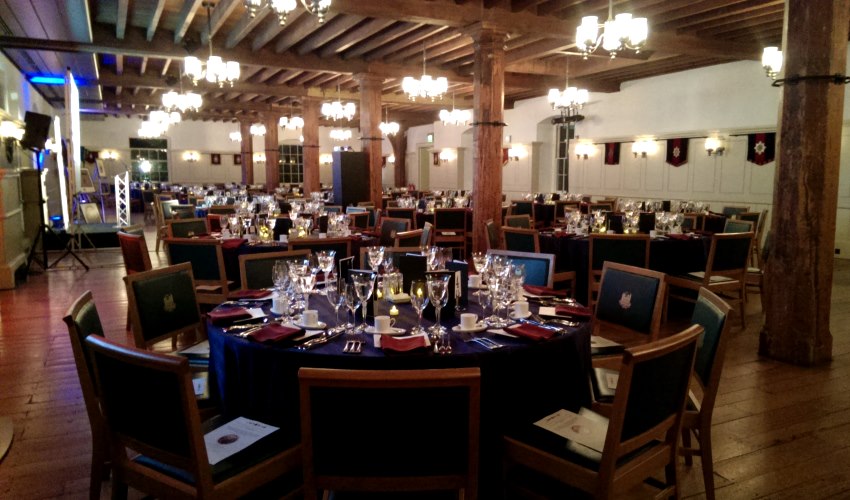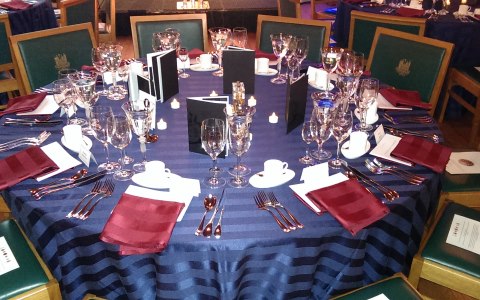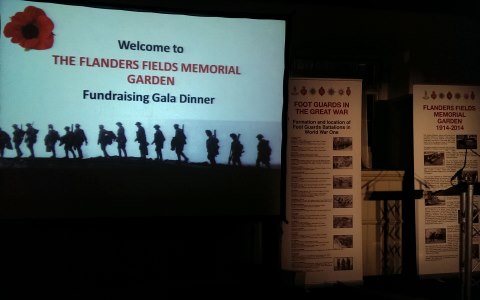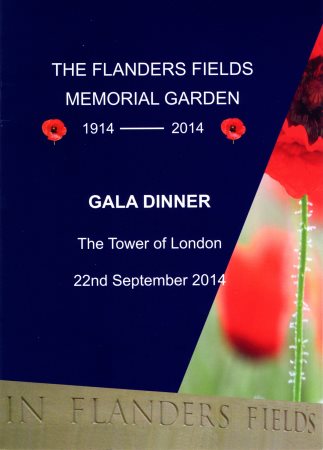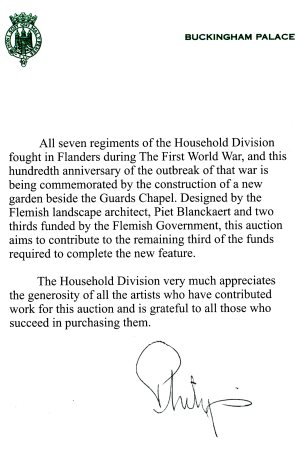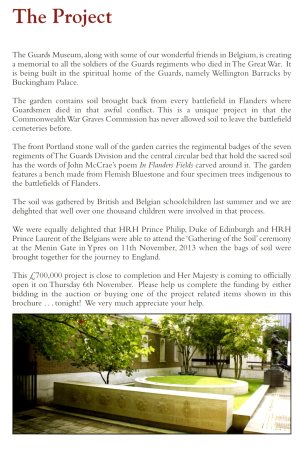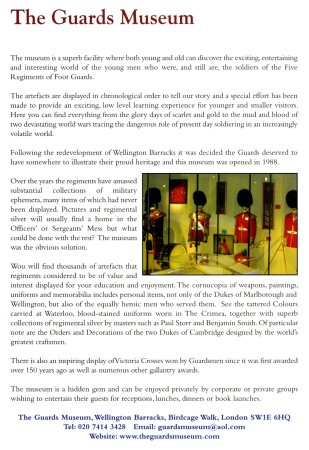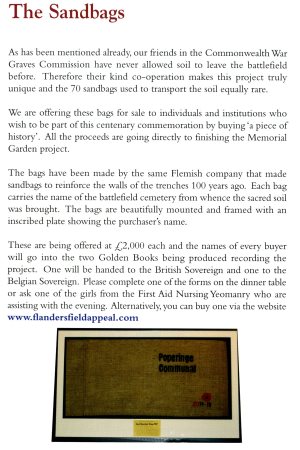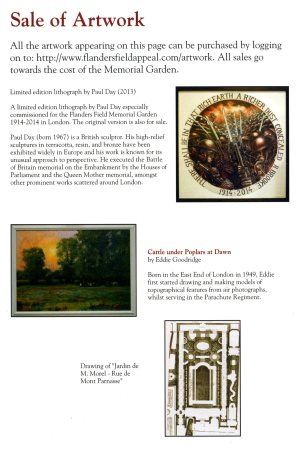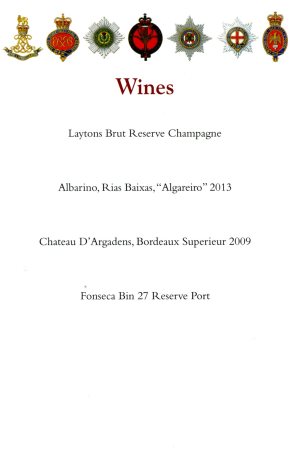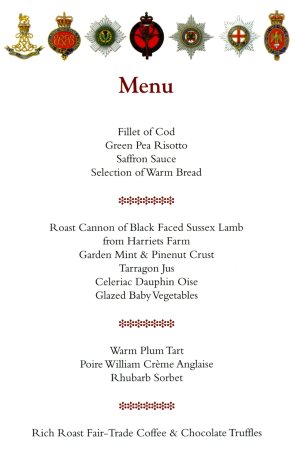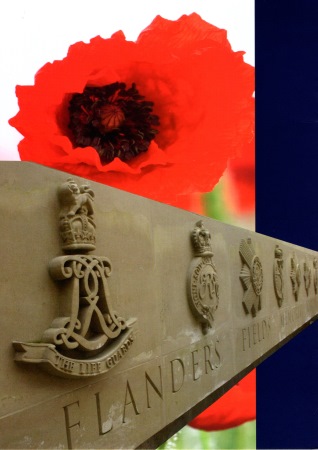
Tel: 020 7620 1818 email: cookandbutler@btconnect.com
The Flanders Fields Memorial Garden 1914 - 2014
www.memorial2014.com
Gala
Dinner
September 2014, The Tower of London

Introduction
All seven regiments of the Household Division fought
in Flanders during The First World War, and this hundredth anniversary
of the outbreak of that war is being commemorated by the construction of
a new garden beside the Guards Chapel. Designed by the Flemish landscape
architect, Piet Blanckaert and two thirds funded by the Flemish
Government, this auction aims to contribute to the remaining third of
the funds required to complete the new feature.
The Household Division very much appreciates the generosity of all the
artists who have contributed work for this auction and is grateful to
all those who succeed in purchasing them.

The Project
The Guards Museum, along with some of our wonderful
friends in Belgium, is creating a memorial to all the soldiers of the
Guards regiments who died in The Great War. It is being built in the
spiritual home of the Guards, namely Wellington Barracks by Buckingham
Palace.
The garden contains soil brought back from every battlefield in Flanders
where Guardsmen died in that awful conflict. This is a unique project in
that the Commonwealth War Graves Commission has never allowed soil to
leave the battlefield cemeteries before.
The front Portland stone wall of the garden carries the regimental
badges of the seven regiments of The Guards Division and the central
circular bed that hold the sacred soil has the words of John McCrae's
poem In Flanders Fields carved
around it. The garden features a bench made from Flemish Bluestone and
four specimen trees indigenous to the battlefields of Flanders. The soil
was gathered by British and Belgian schoolchildren last summer and we
are delighted that well over one thousand children were involved in that
process.
We were equally delighted that HRH Prince Philip, Duke of Edinburgh and
HRH Prince Laurent of the Belgians were able to attend the 'Gathering of
the Soil' ceremony at the Menin Gate in Ypres on 11th November, 2013
when the bags of soil were brought together for the journey to England.
This £700,000 project is close to completion and Her Majesty is coming
to officially open it on Thursday 6th November. Please help us complete
the funding by either bidding in the auction or buying one of the
project related items shown in this brochure... tonight! We very much
appreciate your help.

The Guards Museum
The museum is a superb facility where both young and
old can discover the exciting, entertaining and interesting world of the
young men who were, and still are, the soldiers of the Five Regiments of
Foot Guards.
The artefacts are displayed in chronological order to tell our story and
a special effort has been made to provide an exciting, low level
learning experience for younger and smaller visitors. Here you can find
everything from the glory days of scarlet and gold to the mud and blood
of two devastating world wars tracing the dangerous role of present day
soldiering in an increasingly volatile world.
Following the redevelopment of Wellington Barracks it was decided the
Guards deserved to have somewhere to illustrate their proud heritage and
this museum was opened in 1988. Over the years the regiments have
amassed substantial collections of military ephemera, many items of
which had never been displayed. Pictures and regimental silver will
usually find a home in the Officers' or Sergeants' Mess but what could
be done with the rest? The museum was the obvious solution.
You will find thousands of artefacts that regiments considered to be of
value and interest displayed for your education and enjoyment. The
cornucopia of weapons, paintings, uniforms and memorabilia includes
personal items, not only of the Dukes of Marlborough and Wellington, but
also of the equally heroic men who served them. See the tattered Colours
earned at Waterloo, blood-stained uniforms worn in The Crimea, together
with superb collections of regimental silver by masters such as Paul
Storr and Benjamin Smith. Of particular note are the Orders and
Decorations of the two Dukes of Cambridge designed by the world's
greatest craftsmen.
There is also an inspiring display of Victoria Crosses won by Guardsmen
since it was first awarded over 150 years ago as well as numerous other
gallantry awards. The museum is a hidden gem and can be enjoyed
privately by corporate or private groups wishing to entertain their
guests for receptions, lunches, dinners or book launches. Website:
www.theguardsmuseum.com

The Sandbags
As has been mentioned already, our friends in the
Commonwealth War Graves Commission have never allowed soil to leave the
battlefield before. Therefore their kind co-operation makes this project
truly unique and the 70 sandbags used to transport the soil equally
rare.
We are offering these bags for sale to individuals and institutions who
wish to be part of this centenary commemoration by buying 'a piece of
history'. All the proceeds are going directly to finishing the Memorial
Garden project.
The bags have been made by the same Flemish company that made sandbags
to reinforce the walls of the trenches 100 years ago. Each bag carries
the name of the battlefield cemetery from whence the sacred soil was
brought. The bags are beautifully mounted and framed with an inscribed
plate showing the purchaser's name.
These are being offered at g2,000 each and the names of every buyer will
go into the two Golden Books being produced recording the project. One
will be handed to the British Sovereign and one to the Belgian
Sovereign. Please complete one of the forms on the dinner table or ask
one of the girls from the First Aid Nursing Yeomanry who are assisting
with the evening.

Sale of Artwork
Limited edition lithograph by Paul Day (2013)
A limited edition lithograph by Paul Day especially commissioned for the
Flanders Field Memorial Garden 1914-2014 in London. The original version
is also for sale.
Paul Day (born 1967) is a British sculptor. His high-relief sculptures
in terracotta, resin, and bronze have been exhibited widely in Europe
and his work is known for its unusual approach to perspective. He
executed the Battle of Britain memorial on the Embankment by the Houses
of Parliament and the Queen Mother memorial, amongst other prominent
works scattered around London.
Cattle under Poplars at Dawn by Eddie Goodridge
Born in the East End of London in 1949, Eddie first started drawing and
making models of topographical features from air photographs, whilst
serving in the Parachute Regiment.
Drawing of "Jardin de M. Morel - Rue de Mont Parnass"
![]()
